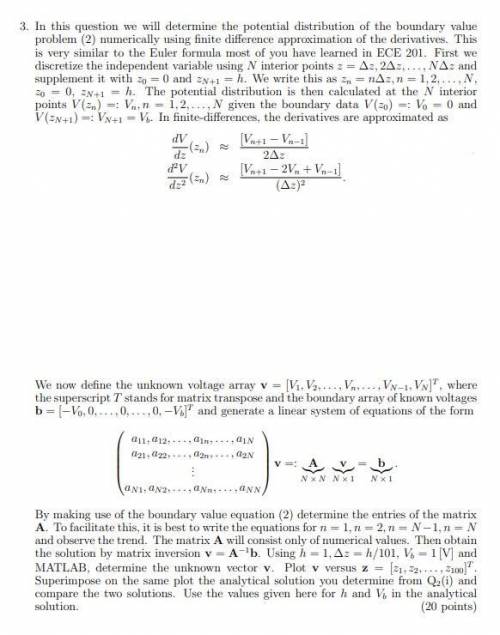
Engineering, 23.02.2022 15:10 chelsey54
In this question we will determine the potential distribution of the boundary value
problem (2) numerically using finite difference approximation of the derivatives. This
is very similar to the Euler formula most of you have learned in ECE 201. First we
discretize the independent variable using N interior points z = ∆z, 2∆z, . . . , N∆z and
supplement it with z0 = 0 and zN+1 = h. We write this as zn = n∆z, n = 1, 2, . . . , N,
z0 = 0, zN+1 = h. The potential distribution is then calculated at the N interior
points V (zn) =: Vn, n = 1, 2, . . . , N given the boundary data V (z0) =: V0 = 0 and
V (zN+1) =: VN+1 = Vb. In finite-differences, the derivatives are approximated as
dV
dz (zn) ≈
[Vn+1 − Vn−1]
2∆z
(3)
d
2V
dz2
(zn) ≈
[Vn+1 − 2Vn + Vn−1]
(∆z)
2
. (4)
We now define the unknown voltage array v = [V1, V2, . . . , Vn, . . . , VN−1, VN ]
T
, where
the superscript T stands for matrix transpose and the boundary array of known voltages
b = [−V0, 0, . . . , 0, . . . , 0, −Vb]
T and generate a linear system of equations of the form
a11, a12, . . . , a1n, . . . , a1N
a21, a22, . . . , a2n, . . . , a2N
.
.
.
aN1, aN2, . . . , aNn, . . . , aNN
v =:
|{z}
A
N × N
v
|{z}
N × 1
= b
|{z}
N × 1
. (5)
By making use of the boundary value equation (2) determine the entries of the matrix
A. To facilitate this, it is best to write the equations for n = 1, n = 2, n = N −1, n = N
and observe the trend. The matrix A will consist only of numerical values. Then obtain
the solution by matrix inversion v = A−1b. Using h = 1, ∆z = h/101, Vb = 1 [V] and
MATLAB, determine the unknown vector v. Plot v versus z = [z1, z2, . . . , z100]
T
.
Superimpose on the same plot the analytical solution you determine from Q2(i) and
compare the two solutions. Use the values given here for h and Vb in the analytical
solution.


Answers: 2
Another question on Engineering

Engineering, 04.07.2019 18:10
Ajournal bearing has a journal diameter of 3.250 in with a unilateral tolerance of 20.003 in. the bushing bore has a diameter of 3.256 in and a unilateral tolerance of 0.004 in. the bushing is 2.8 in long and supports a 700-lbf load. the journal speed is 900 rev/min. find the minimum oil film thickness and the maximum film pressure for both sae 20 and sae 20w-30 lubricants, for the tightest assembly if the operating film temperature is 160°f. a computer code is appropriate for solving this problem.
Answers: 3

Engineering, 04.07.2019 18:10
Burgers vector is generally parallel to the dislocation line. a)-true b)-false
Answers: 2

Engineering, 04.07.2019 18:20
Avolume of 2.65 m3 of air in a rigid, insulated container fitted with a paddle wheel is initially at 264 k, 5.6 bar. the air receives 432 kj by work from the paddle wheel. assuming the ideal gas model with cv = 0.71 kj/kg • k, determine for the air the amount of entropy produced, in kj/k
Answers: 2

Engineering, 04.07.2019 19:10
Estimate the change in specific internal energy au and specific enthalpy h from inlet to outlet for ethylene glycol (a liquid) flowing through each of the following devices: (a) a heat exchanger where the glycol temperature increases from 20 °c to 80 °c; (b) a pump operating at about 25 °c and increasing the glycol pressure from 100 kpa to 8 mpa.
Answers: 2
You know the right answer?
In this question we will determine the potential distribution of the boundary value
problem (2) nu...
Questions


History, 20.04.2021 01:10



Mathematics, 20.04.2021 01:10

Mathematics, 20.04.2021 01:10


English, 20.04.2021 01:10

Mathematics, 20.04.2021 01:10


Social Studies, 20.04.2021 01:10


English, 20.04.2021 01:10


Mathematics, 20.04.2021 01:10

English, 20.04.2021 01:10



Arts, 20.04.2021 01:10

Mathematics, 20.04.2021 01:10



